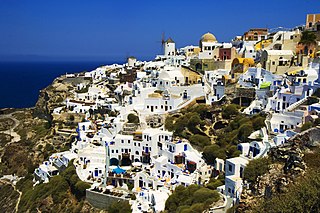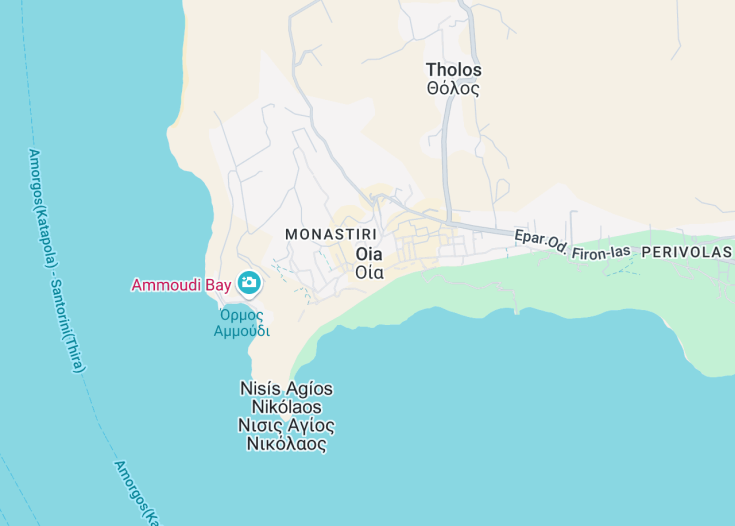Perched atop the cliffs of the island of Santorini, Oia is renowned for its breathtaking sunsets, whitewashed buildings with blue domes, and panoramic views of the Aegean Sea.
This picturesque village offers a unique blend of stunning landscapes, sophisticated architecture, and rich cultural heritage, making it an iconic symbol of Greek beauty. Visitors can explore its narrow, winding paths lined with charming boutiques and cafes, while soaking in the tranquil atmosphere and scenic beauty that Oia has to offer.
For an unmatched view of Oia’s sunset, head early to Oia Castle to secure a good spot as the area becomes crowded quickly.
Wear comfortable shoes when visiting Oia, as the cobblestone streets are picturesque but can prove challenging to navigate.
Top things to do & see in Oia
Select the following sights and activities to discover best tickets and tours available in Oia.
Oia: A Glimpse into the Aegean Paradise
| Country | Greece |
| Time in Oia | GMT+2 |
| Language spoken | Greek |
| Population | 1,628 (Source: latest census) |
| Currency | Euro (€, EUR) |
| Airports |
|
Situated atop the cliffs of the Santorini caldera, Oia is renowned for its stunning sunsets, whitewashed homes embedded into the rugged clifftops, and a charming combination of quaint local shops, blue-domed churches, and sprawling vineyards.
This picturesque village in Greece not only captures the essence of Aegean beauty but also embodies a rich history dating back to the early Cycladic period. Oia’s dramatic views, luxurious resorts, and serene atmosphere make it a must-visit destination for travelers seeking both relaxation and inspiration.
Where is Oia?
a small coastal town located on the northwestern tip of Santorini, a Greek island in the Aegean Sea.
Distances:
| Route | Distance by car | Time by car |
|---|---|---|
| Athens to Oia | 300 mi | Approx. 8 hours (including ferry) |
| Thessaloniki to Oia | 481 mi | Approx. 12 hours (including ferry) |
What is Oia famous for?
Oia is celebrated for its breathtaking sunsets which attract scores of visitors daily. The scenic view of sun-dipping below the Aegean horizon, framed by Oia’s iconic architecture provides a photogenic and memorable experience.
History
Prehistoric Times – 4000 BC to 1100 BC
Oia, a serene village on the northwestern edge of Santorini, Greece, has a history that stretches back to prehistoric times. Initially inhabited in the early Bronze Age, evidence suggests that the island was an important outpost for advanced maritime cultures, flourishing due to its strategic position in the Aegean Sea. The settlement experienced significant growth and prosperity during the Minoan civilization, as indicated by the impressive remains found in nearby Akrotiri, which was buried under volcanic ash around 1627 BC.
Classical and Hellenistic Period – 1100 BC to 324 AD
After the volcanic eruption that devastated much of Santorini, including Oia, the area saw gradual re-inhabitation by Dorians accompanied by the development of ancient Thera. The subsequent periods brought integration into the Hellenistic kingdom under the rule of Alexander the Great and later the Roman Empire, during which the island served as a modest naval base.
Byzantine and Venetian Period – 324 AD to 1566 AD
The Byzantine era marked a period of cultural flowering in Oia, with Christianity taking root. Several churches built during this era still stand. In 1204, the island fell under Venetian control and Oia was developed into a fortified settlement to protect against pirate raids, gaining its current name from the Venetian phrase “La Roka”.
Ottoman Rule to Modern Era – 1566 AD to Present
With the Ottoman conquest, Oia experienced a decline until the late 19th and early 20th centuries when it emerged as a wealthy maritime center, famous for its shipping magnates and splendid captain houses. Modern times have seen Oia transform into one of the most photographed locations in Greece, beloved for its sunset views, whitewashed structures cascading down the caldera edge, and its resilience through various reconstructions following earthquakes, most notably in 1956.
Visit Oia
What to see and do in Oia, Greece
Experiencing Oia in Greece is truly enchanting, with its iconic blue-domed churches, narrow cobbled streets, and breathtaking views of the caldera. Visitors can explore the Naval Maritime Museum, showcasing the maritime history of Santorini, or wander through the charming galleries showcasing local art.
Not to be missed is the sunset from the famous sunset point, which captivates audiences with its stunning play of colors against the Aegean Sea.
- Explore the old Castle of Oia.
- Visit the Byzantine Castle Ruins for panoramic views.
- Stroll through Amoudi Bay and enjoy fresh seafood.
- Shop at the quaint local boutiques.
Events in Oia
Throughout the year, Oia hosts various cultural events and festivals. The most notable is the Oia International Film Festival held in early September, where filmmakers from around the world showcase their works. Additionally, the Feast of St. Nicholas in December brings local customs to life with traditional music and dances.
Best time to visit Oia
The best times to visit Oia are during the spring (April to early June) and fall (September to October) when the weather is pleasantly warm and the summer crowds have thinned out. This period offers the ideal conditions for exploring the island’s natural beauty and historic sites at a leisurely pace.
Is Oia worth visiting?
Oia is undoubtedly worth visiting for anyone seeking a blend of spectacular natural beauty, rich history, and vibrant cultural experiences.
The picturesque village is not only a photographer’s paradise but also a haven for those looking to immerse themselves in the tranquil yet sumptuous atmosphere of the Cyclades. Each view frames the endless blue of the Aegean Sea, and every sunset spent here becomes a treasured memory, making Oia a bucket-list destination.









